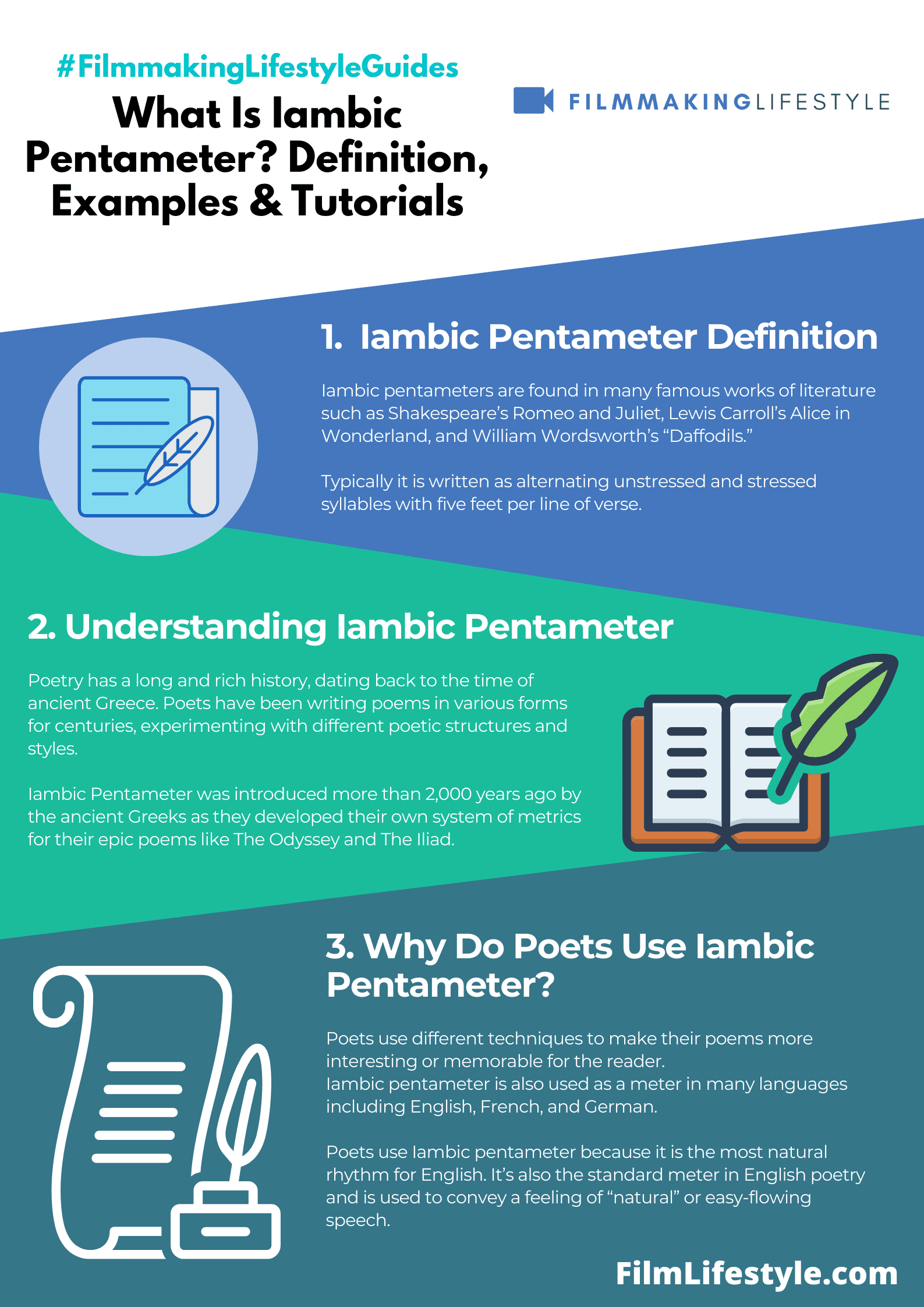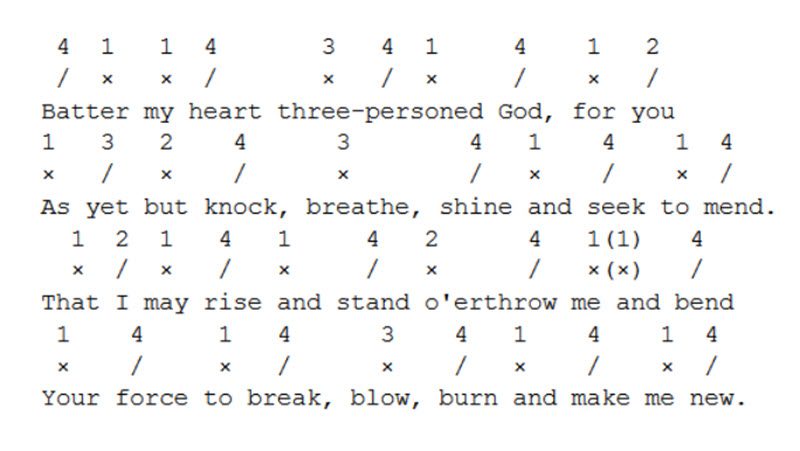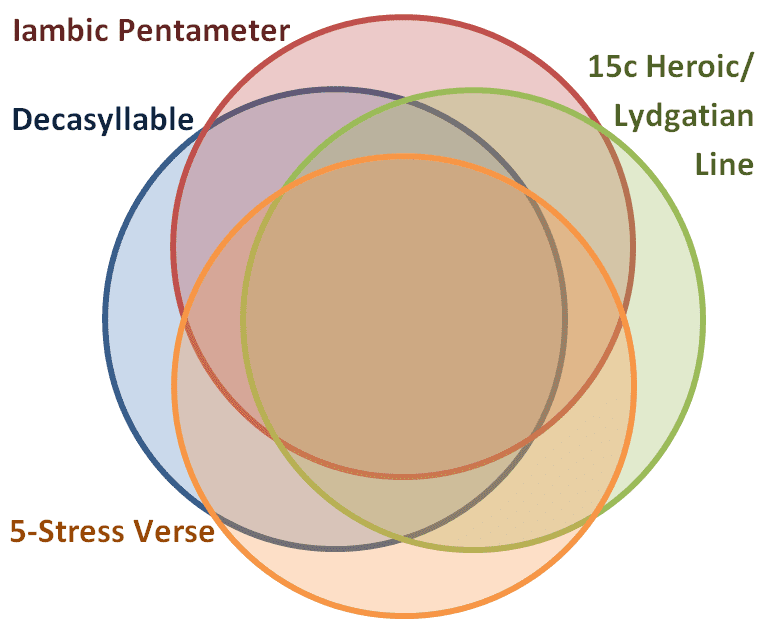An iambic pentameter is a poetic form that consists of five iambic feet per line. The first four feet consist of an unstressed syllable followed by one stressed syllable, and the fifth foot has two stressed syllables.
The word “pent” means five and the word “meter” relates to measuring length, so pentameter can be understood as a measurement for poetry.
Iambic pentameter has been used by poets for centuries and it’s still popular today because it’s easy to understand what the poet is trying to say when they speak in this rhythm.
IAMBIC PENTAMETER
What Is Iambic Pentameter?
Iambic pentameter is a form of English verse that has five iambs per line, or 10 syllables.
The word “pentameter” comes from the Greek word for five parts, and an iamb is two syllables in length.
Iambic pentameters are often found in epic poems like Paradise Lost by John Milton or Beowulf by Anonymous because they can be used to create dramatic tension through long sentences with lots of clauses.
Iambic pentameter isn’t just a fancy term poets throw around—it’s the heartbeat of English poetry.
It’s that rhythmic pattern that’s music to our ears, with its ten syllables dancing to the tune of an unstressed beat followed by a stressed one.
In this article, we’ll unlock the secrets of iambic pentameter, showing you how it’s been the driving force behind the works of legendary wordsmiths like Shakespeare.
Get ready to tap into the rhythm that’s shaped our literary landscape.
The Basics Of Iambic Pentameter
Understanding iambic pentameter starts with recognizing the beat of a line.
Each line comprises five iambic feet, making the beat da-DUM da-DUM da-DUM da-DUM da-DUM.
In the realms of film and scriptwriting, this rhythm can elevate dialogue, creating a poetic flow that captures the audience’s attention.
Recognizing the pattern in literature is like catching the subtle cuts in a well-edited film.
It’s all about the flow and rhythm.
For instance, the opening line of Shakespeare’s Hamlet holds this very meter – listen closely, and you’ll hear the ten syllables marching in step.
Scriptwriters can harness the power of iambic pentameter to add depth to their characters.
The rhythm can reveal a character’s education, background, or even their emotional state, much like the chiaroscuro lighting in a scene might hint at the underlying mood.
The versatility of iambic pentameter is clear.
It shifts with language and emotion.
Let’s look at the different ways this meter can be manipulated:
- by varying the stresses,
- by using punctuation creatively,
- through clever use of enjambment.
This variability mirrors filmmaking techniques.
Just as a director alters pacing with editing decisions, a poet changes the speed and feel of a poem with metrical variations.
The result is a dynamic experience that keeps the audience engaged, whether they’re immersed in a stanza or a scene.
The Structure Of Iambic Pentameter
When we dissect the structure of iambic pentameter, we uncover its rhythmic foundation.
Each line consists of ten syllables – five pairs of alternating unstressed and stressed syllables, or ‘feet.
‘
This meter mirrors natural speech patterns, which is partly why it resonates with audiences.
It often goes unnoticed, yet its presence underpins the listener’s experience.
Exploring its components reveals the power of each foot.
The pattern begins with an unstressed syllable followed by a stressed syllable, often represented as da-DUM.
Implementing iambic pentameter elevates the dialogue in film scripts.
Dialogue constructed in this meter reflects a certain grace and formality.
Notably, in Shakespeare in Love or The Lion in Winter, character dynamics are enriched through carefully measured lines.

Such dialogue projects an aura of sophistication.
The flexibility of iambic pentameter allows for subtle deviations.
These include –
- Variations in the position of the stressed syllable,
- Strategic use of pauses,
- Intentional breaks in the pattern for emphasis.
These nuances function akin to a director’s choices in film – subtle but impactful.
It’s through these choices that dialogue becomes more than words; it becomes an experience.
Understanding the structure of iambic pentameter is more than academic exercise.
It’s recognizing a key tool in our storytelling arsenal.
It offers depth to cinematic dialogue and enriches audiences’ engagement with the characters.
https://youtube.com/watch?v=W-tayWCupD8
The History Of Iambic Pentameter
The origins of iambic pentameter take root in ancient Greece and Rome, where it featured in the works of legendary poets such as Homer and Virgil.
Its structural precision offered a harmonious blend of rhythm and speech that echoed the natural cadences of speech.
Medieval Latin poets continued the tradition, but it was not until the Renaissance that the form blossomed in English poetry.
English playwrights and poets like Geoffrey Chaucer began experimenting with the meter, setting the stage for its popularity.
By the 16th century, iambic pentameter became the dominant poetic form, flourishing under the quills of icons such as William Shakespeare and Christopher Marlowe.
Their plays and sonnets elevated the form, showcasing its flexibility and expressive potential.
Our understanding of how iambic pentameter propels narratives in film can be traced to its theatrical roots.
Here’s how the form was pivotal in its historical context:
- Showcased the prowess of playwrights in capturing the nuances of human speech and emotion,
- Allowed actors to perform with a rhythmic blueprint that could be easily memorized and powerfully rendered,
- Gave audiences a heightened sense of drama through the ebb and flow of the language.
As film evolved, the poetic principles that governed stage plays naturally transitioned onto the silver screen.
Scenes in modern movies sometimes mimic the dramatic beats found in the classic pentameter.
The impact of iambic pentameter on the development of English literature and Later on film dialogue cannot be understated.
It has shaped the art of storytelling, enabling screenwriters to draw from its rich past to script lines that resonate with audiences today.
Famous Examples Of Iambic Pentameter In Literature
Iambic pentameter has graced the pages of some of the most revered works in the English language.
Its rhythm liberates the text while providing a subtle, underlying structure.
Considered the master of iambic pentameter, William Shakespeare infused this metric pattern into his sonnets and plays.
Works like Romeo and Juliet and Macbeth exemplify its musicality and power.
We find iambic pentameter isn’t solely the domain of Elizabethan drama.
It threads through the epic verses of John Milton’s Paradise Lost, a hallmark of 17th-century literature.
The enduring nature of iambic pentameter means it’s featured in more modern texts as well.
One could examine Robert Frost’s poetry, such as in “Stopping by Woods on a Snowy Evening”, to understand its contemporary resonance.
We also observe its presence in the novels of Jane Austen.
Her narrative prose in Pride and Prejudice dances to the beat of iambic pentameter.
The impact of iambic pentameter stretches beyond traditional literature.
We witness its adaptation in various forms of storytelling, including film scripts.
This showcases not only its versatility but also its relevance in modern narrative structure.
To better appreciate the use of iambic pentameter, here’s a breakdown of notable works:
- Hamlet – Enhances the dramatic soliloquies,
- A Midsummer Night’s Dream – Balances the magical with the mundane,
- The Faerie Queene by Edmund Spenser – Melds narrative with iambic flow,
- The Canterbury Tales by Geoffrey Chaucer – Infuses storytelling with rhythmic cadence.
Tracing the use of this metrical foot across the centuries reveals its profound influence on English literature.
Through its recurrence, we see a pattern that speaks to the human ear and experience, irrespective of the era.
How To Write In Iambic Pentameter
Crafting a line of poetry in iambic pentameter starts with understanding its rhythm.
The heartbeat of the line is an alternation of unstressed and stressed syllables, creating a da-DUM da-DUM da-DUM da-DUM da-DUM pattern.
To master this poetic form, it’s essential to first get to grips with the basics of syllable stress.
In English, every word has one or more syllables, and within each word, there’s at least one syllable that’s emphasized more than the others.
Here are straightforward steps for constructing a line of iambic pentameter:
- Choose the words carefully – each line should have ten syllables total,
- Read aloud – listening to the natural stress patterns helps ensure correct iambic rhythm,
- Practice with filler words if stuck – sometimes “to”, “and”, “but”, “for”, “the” can help adjust the meter,
- Maintain the pattern but don’t sacrifice natural language – clarity and meaning should remain intact.
When integrating iambic pentameter into screenwriting or scriptwriting for film, the same principles apply.
The dialogue should flow naturally, honoring the rhythmic structure without feeling forced or stilted.
Mastering iambic pentameter involves both an intellectual understanding of the rules and a practical sense of rhythm and flow.
It’s a delicate balance where practice makes perfect, and often, reading the works of masters like Shakespeare offers invaluable insight.
One of the greatest benefits of writing in iambic pentameter is its near-universal compatibility with the nuances of English speech.
This makes it a powerful tool not only in poetry and classic literature but also in the evocative scripts of today’s films.
Engaging audiences with dialogue anchored in iambic pentameter can add a layer of richness and depth to cinematic storytelling.
It’s the seamless merging of a centuries-old poetic form with the dynamic visual narratives of the silver screen.
Iambic Pentameter – Wrap Up
We’ve seen how iambic pentameter isn’t just a relic of the past but a vibrant part of our literary and cinematic heritage.
Its rhythmic pulse beats through the lines of classic and contemporary works alike adding a layer of sophistication to the spoken word.
Whether you’re a budding poet a screenwriter or simply a lover of language embracing this timeless meter can transform your writing into something truly memorable.
Let’s carry forward the tradition of iambic pentameter as we craft our own stories and contribute to the rich tapestry of English storytelling.
Frequently Asked Questions
What Is Iambic Pentameter?
Iambic pentameter is a meter in poetry that has five iambic feet per line, each with one unstressed syllable followed by a stressed syllable.
Why Is Iambic Pentameter Important In English Poetry?
Iambic pentameter is important because it closely mimics the rhythm of natural speech, giving poetry a melodious quality and has been essential in the works of famous poets like Shakespeare and Milton.
Can You Name Some Writers Who Used Iambic Pentameter?
Famous writers who used iambic pentameter include William Shakespeare, John Milton, Robert Frost, and Jane Austen.
Has Iambic Pentameter Been Used Outside Of Poetry?
Yes, iambic pentameter has been adapted for use in film scripts, demonstrating its versatility in storytelling beyond traditional poetry.
How Do You Write In Iambic Pentameter?
To write in iambic pentameter, understand and apply syllable stress, creating lines of ten syllables with an unstressed syllable followed by a stressed one, and maintain a natural flow of language.
What Are The Benefits Of Using Iambic Pentameter In Screenwriting?
Using iambic pentameter in screenwriting can add depth and a rhythmic quality to dialogue, enhancing the storytelling impact in cinematic narratives.





